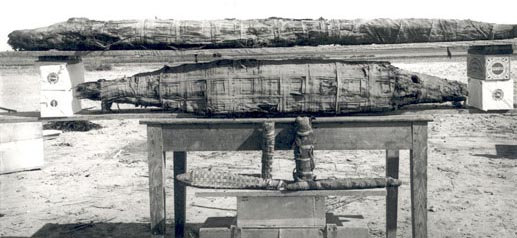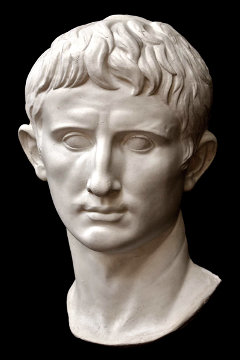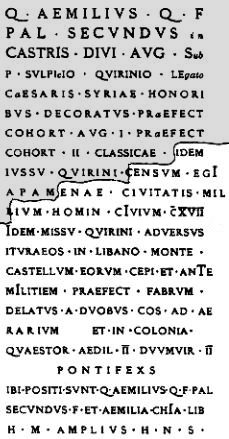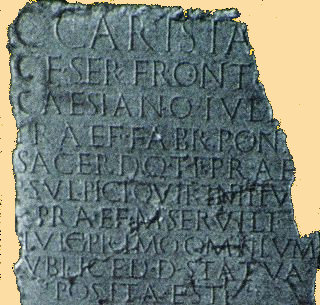Crocodiles and the Birth of Christ
In 1899 UC Berkeley persuaded the American heiress Phoebe A. Hearst to finance an archaeological expedition to Egypt. The archaeologists followed the common practice of awarding their workers bucksheesh for any finds that were made. The amount of bucksheesh varied according to the intrinsic value or the rareity of the objects discovered.

| |
| Two of the Tebtunis crocodiles. The photograph is from the Egypt Exploration Society |
The first crocodile mummy brought its lucky discoverer a handsome amount of bucksheesh, but as one crocodile after another was found the value dropped to almost nothing. Anthony S. Bliss, curator of the UC Berkeley Bancroft Library papyrus collection, says, "The Hearst expedition found huge crocodile cemeteries. Acres. Hundreds and hundreds of mummified crocodiles."
Hardly surprising, given that Tebtunis, where they were excavating, was a centre of worship for the crocodile god Sobek. One day, in exasperation at digging up yet another mummified reptile, the workman hurled the object to the ground, where it split and spilled a cascade of crumpled papyrus. Bliss again: "The story is told that one day, a workman was digging hoping to unearth human mummies and unearthed yet another worthless crocodile. He pulled it out of the sand and chucked it, just heaved it out of the way. It must have hit a rock or something because it broke open and then it was discovered that the crocodile was stuffed with papyri. Needless, to say, this led to a whole new attitude about the crocodile mummies."
It turned out that the ancient embalmers had used discarded papyrus to pad out the interior of the defunct crocodiles - and as papyrus, rather than crocodile mummies, was the object of the expedition, the previously discovered mummies were investigated and the bucksheesh for mummies soared. Regrettably, retrieving the papyrus from the interior of the crocodiles did not contribute to the health of the mummies and only three survived the process to go on display in the Berkeley museum!
Other archaeologists made their discoveries on the rubbish dumps, for example at Oxyrhyncus, where the buildings of the town held little interest but the heaps of rubbish dumped outside the town proved a veritable mine of discarded papyrii. The items which hit the headlines were copies of long-lost works by classical authors such as Sappho, Virgil, Euripiedes and Homer.
More valuable, from the historian's point of view, were the thousands of personal documents, everything from letters written by prodigal sons begging for forgiveness, to wills, bills, title deeds and other legal documents. Even more interesting was the fact that these documents were written in a style of Greek hitherto only known in the New Testament and which was so different from the Classical Greek to which scholars were accustomed that some even called the strange dialect "Holy Spirit Greek". It now turns out that this "Koine Greek" was, in fact, the common tongue of people in the First Century AD.
From these documents we learn that the Romans conducted a census, or enrollment, every fourteen years.Those who were enrolled in the census had to make a declaration of their personal circumstances similar to this one, which dates from AD 47/48.
To Dorion strategus ... from Thermoutharion, the daughter of Thoonis, with her guardian Apollonius, the son of Sotades. There are living in the house which belongs to me in South Lane ... Thermoutharion, a freedwoman of the above-mentioned Sotades, about 65 years of age, of medium height, dark complexioned, long visaged, a scar on the right knee. Total, three persons.
I, the above-mentioned Thermoutharion, along with my guardian, the said Apollonius, swear by Tiberius Claudius Caesar Augustus Germanicus Emperor, that assuredly the preceding document makes a sound and true return of those living with me, and that there is no one else living with me, neither a stranger, nor an Alexandrian citizen, nor a freedman, nor a Roman citizen, nor an Egyptian, in addition to the aforesaid. If I am swearing truly, may it be well with me; but if falsely, the reverse.
In the ninth year of Tiberius Claudius Caesar Augustus Germanicus Emperor, Phaophi ...
In the past some have objected to the Bible account of the census at the time of Jesus' birth, claiming that the Romans did not obliged people to return to their ancestral homes to be counted. Another Egyptian papyrus, currently held in the British Museum, shows that in fact St Luke was entirely accurate in his account of Jesus' birth.
Seeing that the time has come for the house-to-house census, it is necessary to compel all those who for any cause whatever are residing out of their nomes to return to their own homes, that they may both carry out the regular order of the census, and may also attend diligently to the cultivation of their allotments.

| |
| Octavian, who became known as Caesar Augustus. |
The earliest census for which the papyrii provide evidence is from the year AD 19/20, but it is believed that the system of enrollments was instituted by Caesar Augustus, who died in AD 14. Assuming that the fourteen year cycle was maintained, that would place the previous census in AD 5/6.
However Octavian was given the title "Augustus" in 27 BC and it is likely that the census in AD 5/6 was not the first. The one before that would have been in 12/11 BC and before that in 26/25 BC. Although we have no record of such a census it is not at all unlikely that Augustus, the great organiser, would have instituted one fairly early in his reign, so the date 26/25 BC is not improbable. The historian Dio Cassius mentions that Augustus carried out a census during which, in his role as censor, he was forbidden to look at the dead bodies of Agrippa or Octavia. Agrippa died in 12 BC and Octavia in 11 BC, neat confirmation of our conclusion that there was a census in 12/11 BC.
All this has a bearing on a very vexed question - the year of Jesus' birth. According to St Luke, "And it came to pass in those days, that there went out a decree from Caesar Augustus, that all the world should be taxed." (Luke 2:1) In the next verse he adds that "this taxing was first made when Cyrenius was governor of Syria." Most attempts to date the birth of Jesus look at Cyrenius to try and fix the date of the taxation.
Josephus, in his History of the Jews states that
Now Cyrenius, a Roman senator, and one who had gone through other magistracies, and had passed through them till he had been consul, and one who, on other accounts, was of great dignity, came at this time into Syria, with a few others, being sent by Caesar to be a judge of that nation, and to take an account of their substance. Coponius also, a man of the equestrian order, was sent together with him, to have the supreme power over the Jews. Moreover, Cyrenius came himself into Judea, which was now added to the province of Syria, to take an account of their substance, and to dispose of Archelaus's money.
There are several problems with this. In the first place, Cyrenius was appointed as governor in the year AD 6/7, which is believed to be unfeasibly late for the birth of Christ. In the second, it followed the removal of Archelaus as ruler whereas St Matthew makes it plain that Jesus was born several years before Archeleus even began his reign. (Matthew 2:21, 22) As generations of Nativity plays make clear, Jesus was born during the reign of Herod the Great, who died in 4 BC.
As noted above, a census in AD 6 would fit the fourteen year cycle, but it would not fit with either the record that Herod was the king at the time and that Archeleus began to reign after Jesus' birth, nor with the statement by Luke that in the 15th year of Tiberius (AD 27 by Jewish reckoning) Jesus was "about thirty years old" (Luke 3:23)
There is the additional consideration that if we understand Luke to be saying that Augustus did not try to tax the Roman empire until AD 6, only a few years before his death, we are making him to be very imprudent financially. In fact the record is clear that fiscal reform was undertaken early in Augustus' reign. Wikipedia records, "The measures of taxation in the reign of Augustus were determined by population census, with fixed quotas for each province. Citizens of Rome and Italy paid indirect taxes, while direct taxes were exacted from the provinces."
Various suggestions have been made to explain the difficulty, often focussing on the precise meaning of Luke's words. As I am not an expert in Koine Greek (or any other kind of Greek!) I leave such debates to those who are. What does interest me is the question, "If the census of Luke 2 was not in AD 6/7, when was it?"
There are two possibilities: the first is that Luke's census was some local event, either special for Palestine or part of a general census that had somehow been delayed by Herod the Great. In view of Luke referring to "all the world", the first possibility seems to me unlikely. Thus we must either assume that the taxation took place, most probably in 12/11 BC, or that the taxation took place later out of consideration for Herod.

| |
| A copy of the Lapis Venetus inscription. The upper part has since been lost. |
Of interest here is the "Lapis Venetus", a badly damaged tombstone now in the Vatican. The inscription translates as:
Quintus Aemelius Secundus, son of Quintus, of the gens Palatina, in the military field service of the Divine Augustus under Publius Sulpicius Quirinius, Legate of Caesar, in Syria. He was decorated with military honours: Prefect of the First Augustan Cohort, Prefect of the II Cohort Classica.
By order of Quirinius I made a census of the city of Apamea, which had 117,000 citizens; the same was sent by Quirinius against the Itureans. I seized one of their strongholds on Mount Lebanon. At the beginning of my military career I was Prefect of the Engineers, but was appointed to the Aerarium (the Senatorial treasury) by the two consuls and in the colony I was Questor-Aedile twice; I was Duumvir twice; I was also Pontifex Sacrorum.
This was placed here by Q. Aemilius Secundus, son of Quintus, of the gens Palatina, and by Aemlia Chia, former slave woman set free. This monument does not pass on to any heir.
The stone was brought from Beirut in a Venetian ship, onto which it had been loaded as ballast! The inscription was copied and published by Sertorio Orsato in 1676, but then the stone itself went missing. It wasn't until the House of Veniero in Venice was demolished over a century ago that the lower part of the stone was rediscovered. The top part is still missing.
This lower part (below the line in the picture opposite) was studied by Dr. E. J. Vardaman, a noted archaeologist who died in 2000, and he observed tiny letters, which he calls "micro letters" in the second line. These letters are "LA.CONS.P.S.QVIRINI" - "in the first year of the consulship of P.S. Quirinius".
In other words, this stone provides evidence for a census in Syria - Apamea was a Syrian city - which was dated by the consulship of Quirinius, and therefore must be dated to 12/11 BC.

| |
| The Lapis Tiburtinus. The name of its subject is missing but some believe that it refers to Quirinius. |
This conclusion is supported by the Lapis Tiburtinus which refers to someone - the name is missing - who did many of the things which Quirinius is known to have done, and who received "again" the post of legate of Syria. (It is only fair to note that other scholars believe the stone refers to Varus.)
Some have pointed out that in 12 BC Halley's Comet made one of its periodic visits to earth and that it may well have been the "star in the east" seen by the magii and interpreted as a portent of the birth of a king of the Jews. I am not convinced by that, but neither do I entirely dismiss it, but again, astronomical phenomena are not my province.
If Jesus was indeed born in 12/11 BC (and more likely to be in 11 than 12 if Joseph was as reluctant to pay taxes as I am!) then what are we to make of Luke's claim that Jesus was "about thirty" in the year AD 27? He would, in fact, have been nearer forty than thirty!
Personally, I do not believe that to be a problem. People in the east even to this day are commonly uncertain about their exact ages. The fact that thirty was a significant birthday for Jews - it was the equivalent of our twenty-one, the time when a person comes of age - is sufficient reason for Luke or his informants to choose thirty as Jesus' age when He began His public ministry.
It is, however, possible that Herod, fearing revolt - because a census and a taxation went together and were deeply resented - managed to postpone the census by a year or two or, perhaps, spread it out over more than the usual two years and that although it took place in Egypt and Syria in 12/11 BC, it did not take place or did not end in Judea until a year or so later. Not only would that bring Jesus' age closer to thirty, but it would also explain why Luke could not simply consult the records and calculate the exact age. Even if he had been able to work out when the census took place, Mary could not remember whether she and Joseph had made their fateful trip to Bethlehem in the first year or the fourth year of the census period.
12/11 BC No, I am not displaying a lack of ability to count on my fingers. When you cross from BC to AD (or vice versa) you have to add one. The easiest - though least accurate - way of explaining that is to point out that there is no year zero, 1 BC was followed immediately by AD 1! The more accurate way of understanding it is to realise that years are periods of time, not numbers. So from March 2 BC to March 1 BC is a period of one year; from March 1 BC to March 1 AD is a period of two years, even though mathematically -2 to 1 is 3! Return
the census period I am, however, confident that Jesus was not born in 4 BC, a date that is commonly suggested. Herod ordered his soldiers to go and kill all boys "two years old and under" in Bethlehem, which would argue that he suspected that the birth of Jesus had taken place up to two years previously. As 4 BC is the date of Herod's death and the last possible date for Jesus to be born under his rule (which I suspect is why people have chosen the date) that would argue that Jesus was born some time between 6 BC and 4 BC. We do not know in which year Herod ordered the Massacre of the Innocents: it might have been a year or more before his death, which would push Jesus' birth back to 7 BC or 8 BC - which is coming closer to the date of 11 BC suggested by the census dates. Return
© Kendall K. Down 2015





